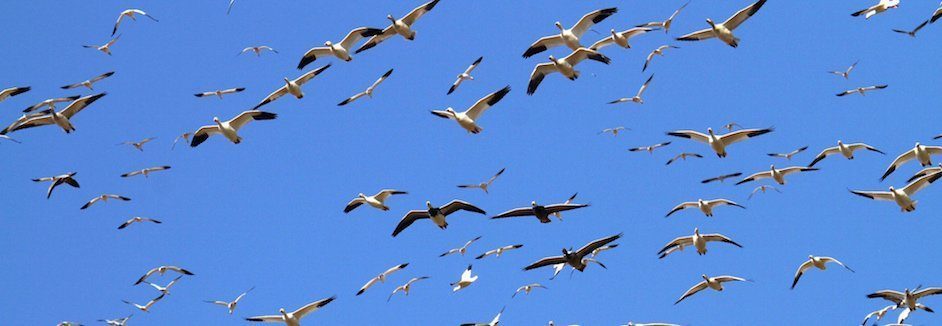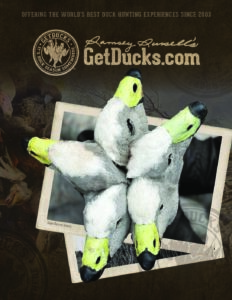Snow Goose
Snow Goose (Chen caerulescens) is divided into two subspecies: Lesser Snow Goose (C. c. caerulescens) and Greater Snow Geese (C. c. atlanticus). Lesser snows described below have a vastly greater population and range than do greater snows. There are also 2 snow goose color phases, white and blue, plus various interphases). Some novice collectors and for-fee “contests” assign species-like designations to color phases in error. Snows, blue and Ross’ geese are collectively referred to as “light geese.”
Available Hunts
The blue-phase snow geese display matching pink bills, legs, and feet; white head, neck, and underbelly; and a dark gray-brown body. Their wings have gray primaries with white coverts that have black along the midrib of the feathers. White-phase adults snows are characterized by white body plumage, except the black wing primaries, and pinkish-orange feet and bill. Both color morphs display a dark gray “grinning patch” that’s an important diagnostic of snow geese. Both color phases may also have their feathers stained a dull yellow due to their appetite for plant tubers, for which they will shove their bills and faces into the ground while “grubbing”. Snow geese are distributed among all 4 North American Flyways.
The Lesser Snow Goose is notably smaller than its Greater counterpart, probably about 25% again smaller; its head and bill proportionately smaller. It breeds from Russia’s Wrangle Island, across arctic North America to Baffin Islands. It’s a highly gregarious species, and the mid-continental population, especially, has increased drastically since the 1980s.
Historically mid-continental snow geese staged in North Dakota wetlands, migrating non-stop to Gulf coastal emergent marshes, which was then their favored wintering habitat. As agricultural rice production expanded, lesser snow geese adapted. Overwintering lesser snow geese can now be found north of the Gulf Coast, into Mississippi, Arkansas, Missouri. As recently as the mid-1990s, daily light geese bag limits were only 5. In 1998, US Congress authorized a Conservation Order, extending light goose take well beyond late-January, and regular season baglimios are drastically increased. This was to manage burgeoning mid-continental populations of lesser snow geese and Ross’ geese, which were doing irreparable harm to the fragile arctic tundra, imperiling not only themselves but other arctic breeding birds. Snow geese are now hunted throughout nearly their entire life-cycle, from Canada to the Gulf Coast, and from September through May.







